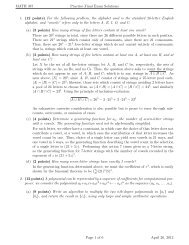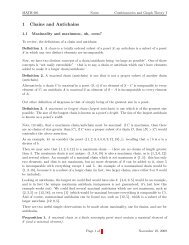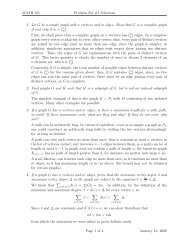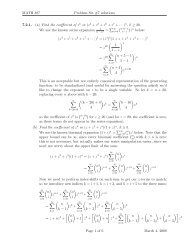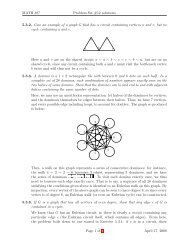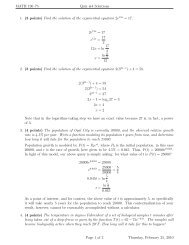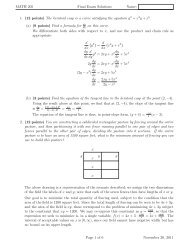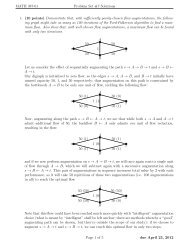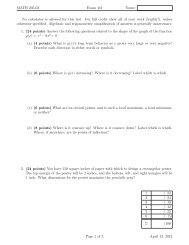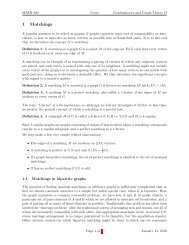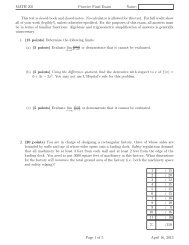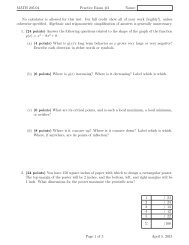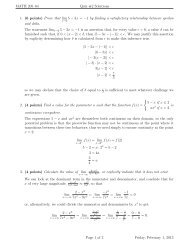MATH 387-01 Problem Set #4 Solutions 1. (20 points) Let a n ...
MATH 387-01 Problem Set #4 Solutions 1. (20 points) Let a n ...
MATH 387-01 Problem Set #4 Solutions 1. (20 points) Let a n ...
You also want an ePaper? Increase the reach of your titles
YUMPU automatically turns print PDFs into web optimized ePapers that Google loves.
<strong>MATH</strong> <strong>387</strong>-<strong>01</strong><br />
<strong>Problem</strong> <strong>Set</strong> <strong>#4</strong> <strong>Solutions</strong><br />
<strong>1.</strong> (<strong>20</strong> <strong>points</strong>) <strong>Let</strong> a n represent the number of ways to distribute n unlableled balls among 3<br />
distinguishable boxes such that each box contains at least 2 and no more than 7 balls.<br />
(a) (5 <strong>points</strong>) Without explicitly calculating the ordinary generating function ∑ ∞<br />
n=0 a nz n ,<br />
determine whether it is a polynomial or an infinite series. State and interpret the degree<br />
of the lowest-degree nonzero term; if it is a polynomial, then also state and interpret the<br />
degree of the highest-degree nonzero term.<br />
According to the given distribution criterion, the fewest balls that can actually be distributed<br />
is 6 (2 to each box), and the most balls that can be distributed is 21 (7 to each<br />
box); thus the only nnzero terms of this sequence are a 6 through a 21 , and so the generating<br />
function consists solely of terms of degree 6 through 21; specifically, it will be a<br />
twenty-first-degree polynomial with smallest term of degree 6.<br />
(b) (5 <strong>points</strong>) Give a formula for the generating function ∑ ∞<br />
n=0 a nz n .<br />
The generating function describing the ball-selection for each box is z 2 + z 3 + z 4 + z 5 +<br />
z 6 + z 7 = z2 −z 8<br />
. Since there are three boxes, the boxes will all be filled when this task is<br />
1−z<br />
completed three times, and so the generating function describing this procedure (and thus<br />
this sequence) is<br />
( ) z 2 − z 8 3<br />
= z6 − 3z 12 + 3z 18 − z 24<br />
1 − z<br />
(1 − z) 3<br />
(c) (10 <strong>points</strong>) Using the generating function from the previous part, determine specifically<br />
how many ways there are to distribute 10 balls among 3 boxes with each box containing at<br />
least 2 and no more than 7 balls.<br />
We want the coefficient specifically of z 10 in this generating function; let us expand the<br />
generating function as such:<br />
z 6 − 3z 12 + 3z 18 − z 24<br />
(1 − z) 3 = (z 6 − 3z 12 + 3z 18 − z 24 )<br />
∞∑<br />
( ) n + 3 − 1<br />
z n<br />
3 − 1<br />
and note that the only term in this product which provides a z 10 term is z 6 · (4+3−1 )<br />
3−1 z 4 =<br />
( 6<br />
)<br />
2 z 10 = 15.<br />
Note that this result could also be obtained fairly easily with direct enumeration (the<br />
condition that no box contains more than 7 balls ends up being a red herring, as 10 balls<br />
cannot be distributed with at least 2 per box in such a way as to violate it), or even<br />
exhaustive search.<br />
2. (10 <strong>points</strong>) Find the ordinary generating functions described below:<br />
(a) (5 <strong>points</strong>) ∑ ∞<br />
n=0 a nz n , where a n is the number of ways to write n as an unordered sum<br />
of positive integers no larger than 4 (e.g. a 6 would be 9, counting the possibilities 4 + 2,<br />
4 + 1 + 1, 3 + 3, 3 + 2 + 1, 3 + 1 + 1 + 1, 2 + 2 + 2, 2 + 2 + 1 + 1, 2 + 1 + 1 + 1 + 1, and<br />
1 + 1 + 1 + 1 + 1 + 1).<br />
We can have any number of 1s, each of which contributes 1 towards the total, so the<br />
selection function for the number of 1s is 1z 0 + 1z 1 + 1z 2 + · · · = 1 . Likewise, we can<br />
1−z<br />
have any number of 2s, each of which contributes 2 towards the total, so the selection<br />
function for the number of 2s is 1z 0 + 1z 2 + 1z 4 + · · · = 1 . In a similar fashion we can<br />
1−z 2 1<br />
determine the selection function for the number of 3s and 4s to be and 1 , so the<br />
1−z 3 1−z 4<br />
generating function for the partitioning of a number into any number of 1s, 2s, 3s, and 4s<br />
n=0<br />
Page 1 of 5 March 5, 2<strong>01</strong>2
<strong>MATH</strong> <strong>387</strong>-<strong>01</strong><br />
<strong>Problem</strong> <strong>Set</strong> <strong>#4</strong> <strong>Solutions</strong><br />
is<br />
1<br />
(1 − z)(1 − z 2 )(1 − z 3 )(1 − z 4 ) .<br />
(b) (5 <strong>points</strong>) ∑ ∞<br />
n=0 b nz n , where b n is the number of ways to write n as an unordered sum of<br />
exactly four positive integers (e.g. b 7 would be 3, counting the possibilities 4 + 1 + 1 + 1,<br />
3 + 2 + 1 + 1, 2 + 2 + 2 + 1).<br />
Since the transpose is a bijective operation, we could count the partitions satisfying this<br />
criterion by counting their transposes instead. Since the transpose of a partition into k<br />
parts (i.e. a Ferrers diagram with k rows) is a partition whose largest part is k (i.e. a<br />
Ferrers diagram with first row of length k), the enumeration b n can be rewritten as “the<br />
number of ways to write n as an unordered sum of positive integers no greater than 4, at<br />
least one of which is exactly 4”. This is a slight variant on the partition described in the<br />
previous part of this question; the selection functions for the number of 1s, 2s, and 3s are<br />
the same as before, but now since we must have at least one 4, the selection function for<br />
including 4s in the sum is 1z 4 + 1z 8 + 1z 12 + · · · =<br />
z4 , so the generating function for this<br />
1−z 4<br />
enumeration is<br />
z 4<br />
(1 − z)(1 − z 2 )(1 − z 3 )(1 − z 4 ) .<br />
3. (10 <strong>points</strong>+5 point bonus) Prove the following equivalences:<br />
(a) (10 <strong>points</strong>) There are the same number of partitions of n into even summands as there<br />
are partitions of n into summands each of which appears an even number of times.<br />
We could prove this via explicit bijection, or by equivalence of generating functions.<br />
For an explicit bijection, we could note that given the partition into even summands<br />
n = 2i 1 + 2i 2 + 2i 3 + · · · + 2i r , we could easily associate it with the partiton n = i 1 + i 1 +<br />
i 2 + i 2 + i 3 + i 3 + · · · + i r + i r , in which each summand appears an even number of times<br />
(for any j, if 2j appeared s times in the original partition, then j appears 2s times in this<br />
new paritition). This is a bijective correspondence since it is reversible: if every summand<br />
appears an even number of times in a partition, we can pair each summand i with another<br />
instance of i and “merge” them into a single summand 2i.<br />
Alternatively, we could work out the generating functions, and note that they are identical.<br />
The generating function for the number of partitions with only even summands can be<br />
taken as the product of the selection functions for 2s, 4s, 6s, 8s, etc. to be<br />
1<br />
(1 − z 2 )(1 − z 4 )(1 − z 6 ) · · · =<br />
∞∏<br />
i=1<br />
1<br />
1 − z 2i<br />
However, the generating function for the number of partitions with an even number of each<br />
summand could be computed as the product of the selection functions for choosing an even<br />
number of each possible summand. When selecting 1s, for instance, the selection function<br />
would be 1z 0 + 0z 1 + 1z 2 + 0z 3 + 1z 4 + 0z 5 + · · · = 1 + z 2 + z 4 + · · · = 1 . Likewise, the<br />
1−z 2<br />
1<br />
selection function for selecting an even number of 2s would be , and so forth, so that<br />
1−z 4<br />
this generating function would in fact be identical to the previously-computed generating<br />
function for the partitions with even summands.<br />
(b) (5 point bonus) There are the same number of partitions of n into summands none of<br />
which are divisible by 3 as there are partitions of n into summands each of which appears<br />
no more than twice.<br />
Page 2 of 5 March 5, 2<strong>01</strong>2
<strong>MATH</strong> <strong>387</strong>-<strong>01</strong><br />
<strong>Problem</strong> <strong>Set</strong> <strong>#4</strong> <strong>Solutions</strong><br />
There is a quite pleasing generating-function approach. The generating function for the<br />
number of partitions of n into summands none of which are divisible by 3 can be written<br />
as a product of the individual generating functions selecting the number of ks: z 0 + z k +<br />
z 2k + z 3k + · · · = 1 for each k not divisible by 3, so the generating function for the<br />
1−z k<br />
number of partitions of n into summands none of which are divisible by 3 can be written<br />
as<br />
1<br />
(1 − z)(1 − z 2 )(1 − z 4 ) · · · =<br />
(1 − z 3 ) (1 − z 6 ) · · ·<br />
(1 − z)(1 − z 2 )(1 − z 3 )(1 − z 4 )(1 − z 5 )(1 − z 6 )(1 − z 7 ) · · ·<br />
= 1 − z3<br />
1 − z · 1 − z6<br />
1 − z · 1 − z9<br />
2 1 − z · · · 3<br />
= (1 + z + z 2 )(1 + z 2 + z 4 )(1 + z 3 + z 6 ) · · ·<br />
which is exactly the generating function describing the number of partitions of n such that<br />
each summand appears no more than twice, since it is the product of selection functions<br />
permitting each summand to be present zero, one, or two times.<br />
There may also be a combinatorial way of looknig at this problem, involving the crafting<br />
of an explicit bijection; it would be interesting to try to do so!<br />
4. (10 <strong>points</strong>) Find the exponential generating function ∑ ∞<br />
n=0 a n zn for the number of ways to<br />
n!<br />
distribute n different objects to six jugglers, if each juggler receives between three and five objects.<br />
The exponential generating function for the nubmer of ways to distribute objects to a single<br />
juggler is 1 z3 + 1 z4 + 1 z5 . The generating function describing the number of ways to distribute<br />
3! 4! 5!<br />
objects to all six is then the product of their six individual functions, which is<br />
( ) z<br />
3<br />
6<br />
3! + z4<br />
4! + z5<br />
.<br />
5!<br />
5. (10 <strong>points</strong>) <strong>Let</strong> the sequence a n be defined by the recurrence relation a 0 = 2, a 1 = 3, and<br />
a n = 2a n−1 + 15a n−2 for n > <strong>1.</strong> Answer the following questions. You may answer the second<br />
part first, if you prefer to use it to answer the first question.<br />
(a) (5 <strong>points</strong>) Find a closed form for a n .<br />
Since this is a homogeneous recurrence relation, any linear combination of solutions to<br />
the recurrence without initial conditions is a solution to the recurrence. <strong>Let</strong> us consider a<br />
prospective solution a n = r n ; then the recurrence a n = 2a n−1 + 15a n−2 can be rewritten<br />
as r n = 2r n−1 + 15r n−2 , or r 2 − 2r − 15 = 0, which is true when r = 5 or r = −3,<br />
so both a n = 5 n and a n = (−3) n are possible solutions to the recurrence alone, as is<br />
a n = k · 5 n + l(−3) n .<br />
To satisfy the initial conditions, it must be the case that 2 = a 0 = k + l and that<br />
3 = a 1 = 5k − 3l. Solving this system of equations gives k = 9 and l = 7 , so the closed<br />
8 8<br />
form for a n is 9·5n +7(−3) n<br />
.<br />
8<br />
This problem can also be done by calculating the generating function first; the derivation<br />
for this method appears at the end of part (b).<br />
(b) (5 <strong>points</strong>) Find a closed form for the ordinary generating function ∑ ∞<br />
n=0 a nz n .<br />
One could build this from the solution to part (a), or build it from the given recurrence<br />
Page 3 of 5 March 5, 2<strong>01</strong>2
<strong>MATH</strong> <strong>387</strong>-<strong>01</strong><br />
<strong>Problem</strong> <strong>Set</strong> <strong>#4</strong> <strong>Solutions</strong><br />
and values. <strong>Let</strong> f(z) = ∑ ∞<br />
n=0 a nz n . Then, by the recurrence:<br />
f(z) = a 0 + a 1 z +<br />
= 2 + 3z +<br />
∞∑<br />
a n z n<br />
n=2<br />
∞∑<br />
(2a n−1 + 15a n−2 )z n<br />
n=2<br />
= 2 + 3z + 2z<br />
∞∑<br />
a n−1 z n−1 + 15z 2<br />
n=2<br />
= 2 + 3z + 2z(f(z) − 2) + 15z 2 f(z)<br />
= 2 − z + 2zf(z) + 15z 2 f(z)<br />
(1 − 2z − 15z 2 )f(z) = 2 − z<br />
2 − z<br />
f(z) =<br />
1 − 2z − 15z 2<br />
∞<br />
∑<br />
n=2<br />
15a n−2 z n−2<br />
Note that if one had done this part first, then part (a) could be completed by finding<br />
coefficients in the power-series expansion of f(z). We would achieve this by the method<br />
of partial fractions:<br />
2 − z<br />
1 − 2z − 15z = 2 − z<br />
2 (1 − 5z)(1 + 3z) = A<br />
1 − 5z + B<br />
1 + 3z<br />
The associated polynomial equivalence (1 + 3z)A + (1 − 5z)B = 2 − z has solution A =<br />
9<br />
8 , B = 7 8 , so<br />
f(z) =<br />
9<br />
7<br />
8<br />
1 − 5z + 8<br />
1 + 3z = 9 8<br />
∞∑<br />
5 n z n + 7 8<br />
n=0<br />
∞∑<br />
(−3) n z n =<br />
n=0<br />
∞∑ 9 · 5 n + 7(−3) n<br />
and since a n is equal to the coefficient of z n in the series representation of f(z), it follows<br />
that a n = 9·5n +7(−3) n<br />
8<br />
(as was alredy seen by a different method above).<br />
6. (10 point bonus) For F 0 = 1, F 1 = 1, and F n = F n−1 + F n−2 for n > 1, prove the following<br />
identities combinatorially (hint: use domino-and-checker tilings of 1-row checkerboards):<br />
(a) (5 point bonus) F 2n = Fn 2 + Fn−<strong>1.</strong><br />
2<br />
We know that F 2n represents the number of ways to tile a 1 × 2n checkerboard with<br />
dominoes and checkers. We may enumerate the same set by a different means via a<br />
casewise analysis on the status of the edge between the nth and (n + 1)th square:<br />
Case I: there is not a single domino covering both the nth and (n+1)th square.<br />
Then we might conceive of this checkerboard covering as simply two 1 × n checkerboard<br />
coverings placed end-to-end (imagine that we simply cut the checkerboard at the edge<br />
between the nth and (n+1)th squares). There are F n ways that the first 1×n checkerboard<br />
could be covered, and F n ways that the second checkerboard could be covered, so these<br />
pairs of checkerboards could be covered in a total of F n × F n = Fn 2 different ways; thus<br />
there are Fn 2 coverings of the 1 × 2n checkerboard described by this case.<br />
Case II: there is a single domino covering both the nth and (n + 1)th square.<br />
Then we might conceive of this checkerboard covering as simply a 1×(n−1) checkerboard<br />
n=0<br />
Page 4 of 5 March 5, 2<strong>01</strong>2<br />
8<br />
z n
<strong>MATH</strong> <strong>387</strong>-<strong>01</strong><br />
<strong>Problem</strong> <strong>Set</strong> <strong>#4</strong> <strong>Solutions</strong><br />
covering, followed by a single domino, followed by another 1×(n−1) checkerboard covering<br />
placed end-to-end (imagine that we simply cut the checkerboard at the edges between the<br />
n − 1th and nth squares and between the nth and (n + 1)th squares). We proceed as seen<br />
in case I and find that each sub-checkerboard can be covered in any of F n−1 ways, so there<br />
are Fn−1 2 possible coverings described in this case.<br />
Since every one of the checkerboards enumerated by F 2n falls into exactly one of these two<br />
cases, it thus follows that F 2n = Fn 2 + Fn−<strong>1.</strong><br />
2<br />
A variant of this argument (where we break at the kth domino instead of at the nth) can<br />
be used to show that, in general, F k+l = F k F l + F k−1 F l−1 ; the argument above is the<br />
special case where k = l.<br />
(b) (5 point bonus) F n = ( ) (<br />
n<br />
0 + n−1<br />
) (<br />
1 + n−2<br />
) (<br />
2 + · · · + ⌈<br />
n<br />
2 ⌉ )<br />
⌊ . n<br />
2 ⌋<br />
We know that F n represents the number of ways to tile a 1×n checkerboard with dominoes<br />
and checkers. We may divide this into cases based on how many dominoes are present.<br />
Note that if we have k dominoes, then we they cover 2k spaces, leaving n − 2k spaces for<br />
checkers. Thus, we are placing in order n − k objects, consisting of k dominoes and n − 2k<br />
checkers. Thus, there are ( )<br />
n−k<br />
k ways to place these objects, sicne we select k of the n − k<br />
positions in the ordering to contain dominoes. Since k can take on any value from 0 to<br />
⌊ n⌋, we thus know that 2<br />
⌊<br />
∑<br />
n 2 ⌋ ( ) n − k<br />
F n =<br />
k<br />
k=0<br />
On two occasions I have been asked — “Pray, Mr. Babbage, if you put into the machine wrong<br />
figures, will the right answers come out?” In one case a member of the Upper, and in the other<br />
a member of the Lower House put this question. I am not able rightly to apprehend the kind of<br />
confusion of ideas that could provoke such a question.<br />
—Charles Babbage<br />
Page 5 of 5 March 5, 2<strong>01</strong>2




